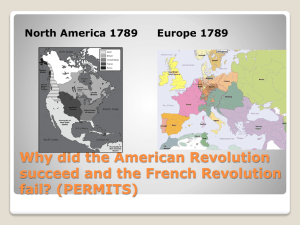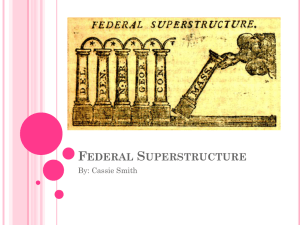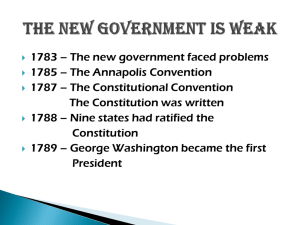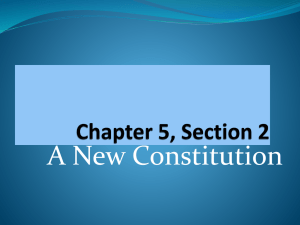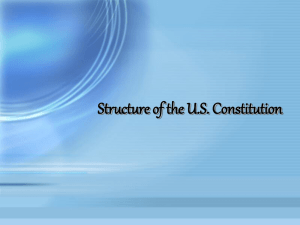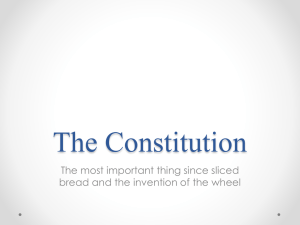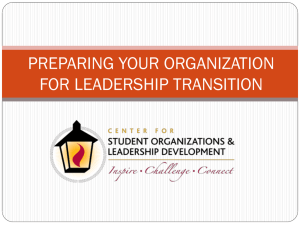PowerPoint
advertisement
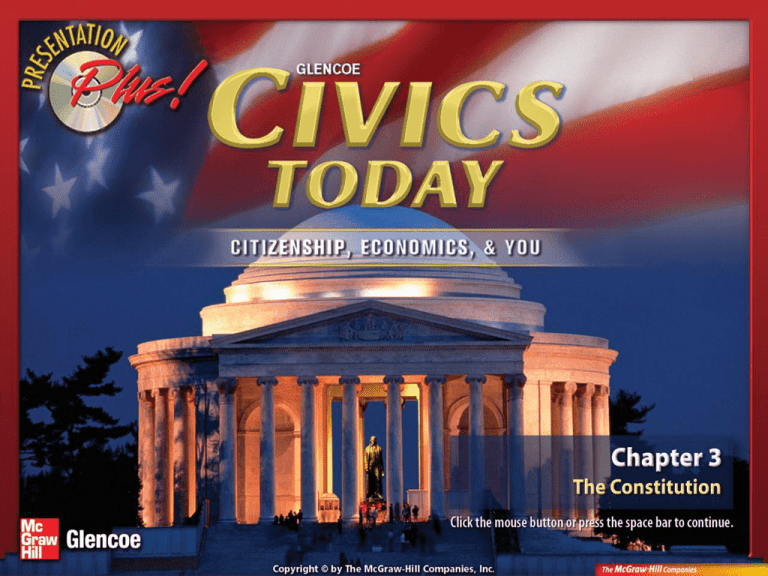
Chapter Introduction Section 1: The Nation’s First Government Section 2: The Road to the Constitution Section 3: The Structure of Our Constitution Section 4: Principles Underlying the Constitution Visual Summary The Constitution outlines the ideals of American government and describes how they should be achieved. It tells you what your rights and privileges are. The Constitution affects you, your family, and your friends as much today as it affected those who wrote it more than 200 years ago. Section 1: The Nation’s First Governments Political principles and major events shape how people form governments. Americans faced the task of forming independent governments at both the state and national levels. Section 2: The Road to the Constitution Political principles and major events shape how people form governments. American leaders decided that a new constitution was needed. Section 3: The Structure of Our Constitution A constitution reflects the values and goals of the society that creates it. The Constitution is this nation’s fundamental law. Section 4: Principles Underlying the Constitution A constitution reflects the values and goals of the society that creates it. The Constitution sets forth the basic principles of government. Guide to Reading Big Idea Political principles and major events shape how people form governments. Guide to Reading Content Vocabulary • constitution • confederation • bicameral • ratify Academic Vocabulary • convert • area • impact Do you think writing a plan for government is a good way to start organizing a government? A. Yes A. A B. B 0% B 0% A B. No The First State Constitutions Americans faced the task of forming independent governments at both the state and national levels. The First State Constitutions (cont.) • When the colonies organized as states, they wrote constitutions, which were written plans for government. • Most state constitutions: – Specified bicameral legislatures – Provided for an elected governor – Based on the ideas of the Declaration of Independence – Included a bill of rights What do you think is the most important thing that a constitution provides? A. A way of electing a governor 0% 0% D A B C 0% D C D. A method for setting up a court system A C. A bill of rights A. B. C. 0% D. B B. A plan for creating a legislature The Articles of Confederation The weaknesses of the Articles of Confederation created problems for the new country. The Articles of Confederation (cont.) • The Articles of Confederation were the first constitution of the United States. • The Articles: – Established a “league of friendship” among states – Ratified by all thirteen states The Articles of Confederation (cont.) – Set up a one-house legislature called the Confederation Congress – Withheld the powers to enforce laws and to tax from the Confederation Congress • Ordinance of 1785: – System created by the Confederation Congress for surveying and selling land – System still used today The Articles of Confederation (cont.) • The Northwest Ordinance: – Provided a way for territories to organize and become new states – Outlawed slavery in the Northwest Territory The Articles of Confederation (cont.) • Weaknesses of the Articles of Confederation: – Votes from nine states needed to pass a law – Unanimous vote needed to change the Articles – Congress unable to enforce laws Weaknesses of the Articles of the Confederation The Articles of Confederation (cont.) • National and state debt after the Revolutionary War • Shay’s Rebellion: – Led by Daniel Shays – Sparked by debt due to heavy state taxes – Armed attack on a federal arsenal – Arguments for a stronger national government Do you agree that the Articles of Confederation were too weak? A. Agree B. Disagree A. A B. B 0% B A 0% Guide to Reading Big Idea Political principles and major events shape how people form governments. Guide to Reading Content Vocabulary • Constitutional • Electoral Convention College • Great Compromise • Three-Fifths Compromise • Federalists • federalism • Anti-Federalists Academic Vocabulary • process • despite Do you think that people in government should try to compromise? A. Yes B. No A. A B. B 0% B A 0% The Philadelphia Convention American leaders decided to create a new plan of government. The Philadelphia Convention (cont.) • The Congress asked each state to send delegates to Philadelphia to fix the problems with the Articles of Confederation. • Constitutional Convention began in Philadelphia’s Independence Hall in 1787. Who Were the Delegates? The Philadelphia Convention (cont.) • Delegates: – 55 in all – Benjamin Franklin as the oldest delegate – George Washington and James Madison as future presidents The Philadelphia Convention (cont.) • Leaders not in attendance: – Thomas Jefferson in Paris – John Adams in London – Patrick Henry against the convention The Philadelphia Convention (cont.) • Important decisions made by the delegates: – George Washington presided over convention. – Each state got one vote and a simple majority would decide any issue. – Work was kept secret. – Created a new constitution, thus called the Constitutional Convention. Why do you think delegates decided a simple majority could decide an issue? A. It prevented larger states from having a bigger influence. B. It helped states with more delegates push through their ideas. 0% C 0% B 0% A C. It streamlined the process, making it easier to move forward with a constitution. A. A B. B C. C Creating the Constitution Many of the provisions of the Constitution were arrived at through a series of compromises. Creating the Constitution (cont.) • The Constitution was the result of a series of compromises that combined the best ideas of different plans. • The Virginia Plan: – Called for a government similar to the one we have today – Two-house congress Creating the Constitution (cont.) – Representation in the two houses of congress based on each state’s population – Favored by larger states Creating the Constitution (cont.) • The New Jersey Plan: – One-house congress – Equal representation and equal votes – Favored by smaller states Creating the Constitution (cont.) • The Great Compromise settling the structure of Congress • The Three-Fifths Compromise settling that every five enslaved persons would count as three free persons • Congress able to regulate trade between states and other countries Creating the Constitution (cont.) • Congress unable to tax exports or interfere with the slave trade before 1808. • Electoral College created to select the president and vice president Which plan is also known as the Great Compromise? A. Virginia Plan B. New Jersey Plan 0% D A B C0% D C 0% A D. Three-fifths Compromise A. B. C. 0% D. B C. Connecticut Compromise Balancing Viewpoints Writing the new Constitution and getting the American people to approve it was not an easy task. Balancing Viewpoints (cont.) • Signing of the Constitution • Various factions interpreted the new Constitution differently. Balancing Viewpoints (cont.) • Federalists: – Supported dividing power between federal and state governments – Supported the Constitution as it was written in Philadelphia Balancing Viewpoints (cont.) • Anti-Federalists: – Opposed a powerful central or national government – Opposed the Constitution as it was written in Philadelphia Balancing Viewpoints (cont.) • Bill of rights added to the Constitution • Ratification of the Constitution Ratification of the Constitution Do you agree that the United States needs a strong national government? A. Agree B. Disagree A. A B. B 0% B A 0% Guide to Reading Big Idea A constitution reflects the values and goals of the society that creates it. Guide to Reading Content Vocabulary • Preamble • judicial branch • legislative branch • amendment • executive branch Academic Vocabulary • consist • assume Do you think it should be easy to change or amend the Constitution? A. Yes B. No A. A B. B 0% B A 0% The Sections of the Constitution The Constitution is a remarkable document that serves as an adaptable blueprint for governing the United States. The Sections of the Constitution (cont.) • The Constitution is divided into three sections: the preamble, the articles, and the amendments. • Preamble: – Establishes that power of government comes from the people – States six purposes of government The Sections of the Constitution (cont.) • Article I: – Creates a two-house legislative branch – Outlines the duties of the Congress in making laws The Sections of the Constitution (cont.) • Article II: – Provides for the executive branch – President carries out and enforces the laws made in Congress – Explains how leaders are elected to office and how they can be removed The Sections of the Constitution (cont.) • Article III: – Establishes the judicial branch – Judicial branch interprets laws – Creates a court system and lists its powers The Sections of the Constitution (cont.) • Articles IV-VII: – Explains relationship between state and national government – Tells how the Constitution can be changed – Declares the Constitution as the “supreme Law of the Land” Comparing Governments Do you agree that the Constitution is a symbol of our nation? A. Agree B. Disagree A. A B. B 0% B A 0% Amending the Constitution The Framers wrote the Constitution so that it could be adapted to meet changing needs. Amending the Constitution (cont.) • The Constitution can be changed or amended to adapt to the country’s changing needs, but amending it is a difficult process. • 27 amendments ratified • Amendments in safeguarding freedoms Amending the Constitution (cont.) • Process for amending the Constitution: – Proposal by congressional action or national convention – Ratification by three-fourths of states Amending the Constitution Amending the Constitution (cont.) • Interpretation: – Necessary and proper clause allows Congress to exercise implied powers – Supreme Court interpretations of the Constitution – Legislative and executive interpretations of the Constitution – Changes made to the Constitution through customs that develop over years How do you view the ability to amend the Constitution? A. It is very necessary B. It is not very necessary 0% D C A D. No opinion A. A B. B C.0% C0% 0% D. D B C. It is somewhat necessary Guide to Reading Big Idea A constitution reflects the values and goals of the society that creates it. Guide to Reading Content Vocabulary • popular sovereignty • expressed powers • rule of law • reserved powers • separation of powers • checks and balances • concurrent powers Guide to Reading Academic Vocabulary • ensure • assign Should one branch of government hold more power than the others? A. Yes B. No A. A B. B 0% B A 0% Major Principles of Government The Constitution sets forth the basic principles of government. Major Principles of Government (cont.) • The Constitution establishes the basic principles of the government of the United States. • Five fundamental principles of government: – Popular sovereignty – The rule of law – Separation of powers Major Principles of Government (cont.) – Checks and balances – Federalism • Changes in the meaning of republic Foundations of Rights Major Principles of Government (cont.) • Popular sovereignty: – Power lies with the people – Ensured by the Constitution through elections Major Principles of Government (cont.) • Rule of law: – Power of the government is limited – Law applies to everyone • Separation of powers: – Branches of government have different functions – Idea influenced by philosopher Montesquieu Major Principles of Government (cont.) • Checks and balances: – Prevents one branch from becoming too powerful – Each branch able to limit the power of the others A System of Check and Balances Which principle of the Constitution do you think is the most important? A. Checks and balances B. Popular sovereignty C. Rule of law D. Separation of powers 0% A A. B. 0% C. D. B A B 0% C D C 0% D The Principle of Federalism The Constitution created a federal system of government. Under federalism, power is divided between national and state governments. The Principle of Federalism (cont.) • The Constitution establishes a system of federalism where power is divided between national and state governments. The Principle of Federalism (cont.) • Three types of government power: – Expressed powers granted to the national government – Reserved powers kept by the states – Concurrent powers exercised by both national and state governments Federal and State Powers The Principle of Federalism (cont.) • Supremacy clause: – Constitution is the highest law – National government or state governments cannot violate the Constitution • The Constitution is both durable and adaptable. How do you view the powers given to the government by the Constitution? A. The Constitution gives the government balanced power. A 0% 0% 0% 0% D D. No opinion A B C D C C. The Constitution gives the government not enough power. A. B. C. D. B B. The Constitution gives the government too much power. The Constitution The Constitution is this nation’s fundamental law. It established that our nation is a republic that includes: • an elected president; • a bicameral legislature; • a system of courts. The Constitution is made up of three parts: • the Preamble • the Articles • the Amendments The Constitution (cont.) The Constitution sets forth the five basic principles upon which the American system of government rests. 1. popular sovereignty 2. the rule of law 3. separation of powers 4. checks and balances 5. federalism The Constitution (cont.) In setting up a federal system, the writers of the Constitution divided the powers of government into three types: • Enumerated powers are those powers the Constitution specifically gives to the national government. • Reserved powers are those that the Constitution gives to the states. • Concurrent powers are those that the national and state governments share. The Supremacy Clause Found in Article VI, the supremacy clause states that the Constitution and the laws of the national government are the “supreme law of the land.” In any conflict between national law and state law, the national law has the higher authority. Amending the Constitution Any change in the Constitution is called an amendment. The Constitution has 27 amendments. It set up a two-house legislature in which representation in one house was the same for all states and representation in the other house was based on population. constitution a detailed, written plan for government bicameral a legislature consisting of two parts, or houses confederation a group of individuals or state governments ratify to vote approval of convert to change from one belief, form, or use to another area a region or section impact to influence or effect Constitutional Convention meeting of state delegates in 1787 leading to adoption of new Constitution Great Compromise agreement providing a dual system of congressional representation Three-fifths Compromise agreement providing that enslaved persons would count as three-fifths of other persons in determining representation in Congress Electoral College a group of people named by each state legislature to select the president and vice president Federalists supporters of the Constitution federalism a form of government in which power is divided between the federal, or national, government and the states Anti-Federalists those who opposed ratification of the Constitution process an action or a series of actions directed toward a result despite in spite of Preamble the opening section of the Constitution legislative branch the lawmaking branch of government executive branch the branch of government that carries out laws judicial branch the branch of government that interprets laws amendment any change in the Constitution consist to be made up of assume to take over a job or responsibility popular sovereignty the notion that power lies with the people rule of law principle that the law applies to everyone, even those who govern separation of powers the split of authority among the legislative, executive, and judicial branches checks and balances a system in which each branch of government is able to check, or restrain, the power of the others expressed powers powers that Congress has that are specifically listed in the Constitution reserved powers powers that the Constitution does not give to the national government that are kept by the states concurrent powers powers shared by the state and federal governments ensure to secure or make sure assign to dole out or give as a task To use this Presentation Plus! product: Click the Forward button to go to the next slide. Click the Previous button to return to the previous slide. Click the Home button to return to the Chapter Menu. Click the Transparency button from the Chapter Menu or Chapter Introduction slides to access the TIME Transparency that is relevant to this chapter. From within a section, click on this button to access the relevant Daily Focus Skills Transparency. Click the Return button in a feature to return to the main presentation. Click the Economics Online button to access online textbook features. Click the Reference Atlas button to access the Interactive Reference Atlas. Click the Exit button or press the Escape key [Esc] to end the chapter slide show. Click the Help button to access this screen. Links to Presentation Plus! features such as Graphs in Motion, Charts in Motion, and figures from your textbook are located at the bottom of relevant screens. This slide is intentionally blank.



